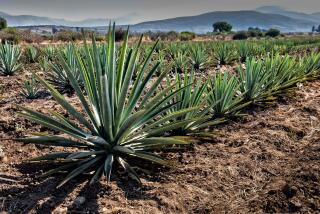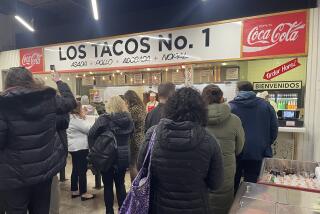On the prowl for the best food — and mezcal — in Oaxaca, Mexico
This city is obsessed with food. And it also happens to have some of the best eating in all of Mexico.
Everywhere you go, something tempts. You find yourself darting like a hummingbird from tender sweet buns with a bowl of hot chocolate (order it with water, not milk, the way locals do), to a plate of chilaquiles in crimson Oaxacan chile sauce, to a bite of luscious ripe mango or one of the Mexican colonial city’s famous moles.
Even those not inclined to snack can find themselves succumbing and happily noshing day and night.
Handmade nieve, or ice cream, for a midmorning snack? Why not? An empanada with a complex mole amarillo? I wouldn’t say no.
When my traveling companions and I stop for a jolt of coffee (made from Oaxacan beans in an AeroPress, no less) midafternoon, a local orders a tejate (a pre-Hispanic maize and cacao beverage) frappé and avocado fries.
Head into the center of town on a late-night mezcal prowl and you end up queuing for a tlayuda — a gigantic crisp tortilla spread with pork lard, beans and other good things — cooked over charcoal at a street stand.
As in San Sebastián, Spain, or Bangkok, Thailand, you can eat incredibly well at every level in Oaxaca, from market stalls to smart contemporary restaurants that can hold their own against top restaurants anywhere in the world. And that’s saying a lot.
No matter how many days you have here, you will never have enough. On a weeklong trip, I ate morning, noon and night and still missed a lot. But that’s a good thing. I know I’ll be back — and soon.
The thought of breakfast at breezy Café Casa Oaxaca or at a simple stand in the Central de Abastos market, where a woman cooks eggs and memelitas (masa patties topped with a vivid salsa and crumbled fresh cheese) on a giant metal comal has me longing to hop on the next plane.
That stand is chef Alejandro Ruiz’s favorite breakfast spot at the market, just past the criollo section where Zapotec Indian women sell braided garlic, foraged herbs, handmade cheeses, wild pears and more from tiny stalls or blankets on the ground.
Land of seven moles
Ruiz, the father of farm-to-table cuisine in Oaxaca, was our guide at the market, threading his way through the crowded, chaotic aisles, stopping to buy wild yellow plums, tiny avocados, “rabbit” herb from the hillsides and local chiles.
Afterward, we sat in the kitchen of his first restaurant, at the seven-room Casa Oaxaca Hotel , while he cooked lunch. (Anybody can sign up for a similar excursion, cooking class and lunch at Casa Oaxaca.)
“Our challenge,” Ruiz says, “is to represent traditional flavors that our mothers cook at home in a restaurant.” As his chef there, Rafael Andres Villalobos, prepares a green mole with chiles and herbs from the market, he explains that Oaxaca may be known as the land of seven moles, but in reality, there are many more. And he learned many of them from the older women who work in the kitchen.
Lunch is a beautiful expression of Oaxacan cuisine, starting with a crisp blue corn tortilla spread with beans and fresh cheese. Corn soup is a startling marigold, the broth stained with red chile and tomato, garnished with corn and cactus paddle. Grilled sea bass, in a delicious green mole thickened with masa and garnished with wild coriander flowers and baby purslane, is a beautiful expression of Oaxacan cuisine.
Teotitlán del Valle, a village about a half-hour outside Oaxaca, is renowned for its intricately patterned hand-woven rugs made from hand-spun, naturally dyed wool — and for the Mendoza sisters’ restaurant, Tlamanalli.
Their brother Arnulfo was the most talented weaver of his generation, and his best pieces sold for thousands of dollars. The cook is his sister Abigail, who has gone as far as Paris to demonstrate pre-Hispanic Zapotec cooking.
She does everything by hand, grinding herbs and chiles on a metate, or grinding stone, kneeling on the dirt floor under the staircase of this otherworldly restaurant. The menu — the restaurant is open only for lunch — is simple: two soups, chicken with one of two moles, and a few desserts. A delicate squash blossom soup is flavored with a leaf that grows wild on the mountain. Farm chicken is cloaked either in a mild red sauce made with toasted ground corn or in a subtle black mole.
At the open-air Sunday market in Tlacolula, a 45-minute drive out of Oaxaca, we bought thin sheets of pork and beef from one of the butcher stands that line both sides of the meat hall. Then we stepped to the center of the room to use one of the charcoal barbecues to grill the meat, along with knob onions and chiles.
The contents were folded into fresh blue corn tortillas, but these sumptuous tacos were just a teaser. After, we headed to the long communal tables in front of Barbacoa Adolfa for sopa de chivo, goat soup, piled with shredded cabbage, radishes, lime and salsa, where we ran into Del Maguey mezcal founder Ron Cooper slurping a bowl.
That DIY barbecue experience didn’t mean I was going to skip the taco corridor in the Mercado 20 de Noviembre in Oaxaca. If it hadn’t been our last day, I assure you, I would have eaten there every day.
Same drill as before, only in this smaller hall, the butchers grill the meat and vegetables for you. We made the best tacos from marinated pork, cecina (slightly dried beef) and chorizo, rolling the thin, freshly made tortillas with avocado and a couple of fiery salsas bought from different vendors.
In between (and there were many in betweens), we ate at Alejandro Ruiz’s Casa Oaxaca el Restaurante, with its gorgeous rooftop terrace overlooking Santo Domingo church. Salsas are made right at the table. Outstanding dish? A velvety black bean soup.
At Origen, Rodolfo Castellanos’ restaurant in an old colonial house, we ate a vibrant, juicy ceviche, sweetbread tostadas and a confit of suckling goat. The San Francisco-trained chef also has a cooking school downstairs where he has workshops with some of the best chefs in Oaxaca.
Plantain balls and suckling pig
La Pitiona may be the most ambitious restaurant in town. José Manuel Baños worked at the eccentric El Bulli and Arzak in Spain, and his food at Pitiona is truly exciting.
I loved a tostada of octopus with white beans and finely diced cactus paddle. Plantain balls have a surprise red wine reduction inside, playing sweet against salty and earthy. Shrimp ceviche in a smoldering red salsa is garnished with blocks of watermelon. Absolutely fabulous is the sweet porky goodness of guanciale (pork jowl) in a pearly pulque sauce made from the milky, slightly viscous beverage fermented from fresh agave sap.
But that’s equaled by the 35-year-old chef’s suckling pig, which you shred with your fork and make into tacos with a green serrano and tomatilla salsa. Dessert is the very fun churros nitro, arroz con leche squirted into liquid nitrogen, where it freezes into the shape of churros. It’s served with warm chocolate to pour over.
If my plane had left a mere hour later, there would have been time for one more breakfast at Café Casa Oaxaca in the upscale Colonia Reforma neighborhood — fabulous chilaquiles in red Oaxacan chile sauce, enfrijolados — fresh tortillas dipped in a black bean slurry and folded like a handkerchief, fresh cheese crumbled over the top — and brilliantly colored tropical juices.
Nearby too is Itanoní Tortillería y Antojería, owned by an agronomist who celebrates and works with heirloom corn. The menu is mostly simple masa dishes, and on the weekends, a killer pozole.
Oaxaca is the land of moles, but it’s also the home of mezcal, the soulful spirit distilled from both wild and domesticated agave, which is practically a religion in Oaxaca. The place to get acquainted is at Mezcaloteca, a nonprofit foundation that’s really a charming bar promoting mezcal with dozens of meticulously curated farmer varieties on hand. Make an appointment for a guided tasting.
You won’t believe the range of flavors possible, depending on altitude, variety of agave and maker. You’ll also want to stop at In Situ, a tiny bar with 180 artisanal mezcals on hand, each with a carefully detailed label drawn by proprietor Ulises Torrentera. You can also buy Del Maguey’s excellent single village mezcal at Cooper’s shop in town, in front of Los Danzantes restaurant. That coffee shop with the Oaxacan beans is just above.
After a week of nonstop eating (and a certain amount of mezcal drinking), Oaxaca was a swirl of impressions and flavors. My biggest regrets: that I had to come home and that I couldn’t figure out how to get one of the 3-foot-wide clay comales back to L.A.
If you go
THE BEST WAY TO OAXACA, MEXICO
From LAX, Aeromexico, United and Alaska offer connecting service (change of planes) to Oaxaca. Restricted round-trip fares from $673 to $951, including taxes and fees.
TELEPHONES
To call the numbers below from the U.S., dial 011 (the international dialing code), 52 (the country code for Mexico) and the local number.
WHERE TO EAT
Casa Oaxaca, 407 Garcia Vigil, Oaxaca; 951-514-4173, www.casaoaxaca.com.mx. This restaurant in chic seven-room hotel is where Alejandro Ruiz began his farm-to-table concept. Doubles from $189. Dinner by reservation only. Market tours, cooking classes and lunch by arrangement. Dinner from $40 per person.
Casa Oaxaca el Restaurante, 104-A Constitución, Colonía Centro, Oaxaca; 951-516-8889, www.casaoaxacaelrestaurante.com. Entrees $8-$20.
Café Casa Oaxaca, 518 Jazmines, Colonía Reforma, Oaxaca; 951-502-6017, www.casaoaxacacafe.com. A 10-minute cab ride from the center, it’s a great spot for breakfast. Mostly locals. Breakfast for two, about $15.
Mezquite, 601-A Garcia Vigil, Colonía Centro; 951-514 2099. Ruiz’s newest spot, with entrees $7-35.
Itanoní Tortillería y Antojería, 513 Belisario Dominguez, Reforma; 951-513-922, www.itanoni.com. Breakfast for two about $15.
La Pitiona, 108 Allende, Colonía Centro, Oaxaca; 951-514-4707, www.pitiona.com/english. Meal for two about $80.
Origen, 820 Hidalgo, Centro Histórico, Oaxaca; 951-501-1764, www.origenoaxaca.com/home.html. Meal for two about $80.
Cofetarika, 403 Macedonio Alcalá, Oaxaca; www.cofetarika.com.
OUTSIDE THE CITY
Tlamanalli, 39 Avenida Juárez, Teotitlán del Valle; 951-524-4006. Lunch only. Reservations required. Meals from $5 to $15.
Adolfa Puesto de Barbacoa, Sunday farmers market in Tlacolula, the biggest in the state of Oaxaca. Meal for two just a few dollars.
MEZCAL BARS
Mezcaloteca, 506 Calle Reforma, Oaxaca; 951-514-0082, www.mezcaloteca.com. Reservations advised. Open 4:30-10 p.m. Tasting $12 per person.
In Situ, 511 José María Morelos, Oaxaca; 951-116-3230
Twitter: @sirenevirbila
More to Read
Sign up for The Wild
We’ll help you find the best places to hike, bike and run, as well as the perfect silent spots for meditation and yoga.
You may occasionally receive promotional content from the Los Angeles Times.






